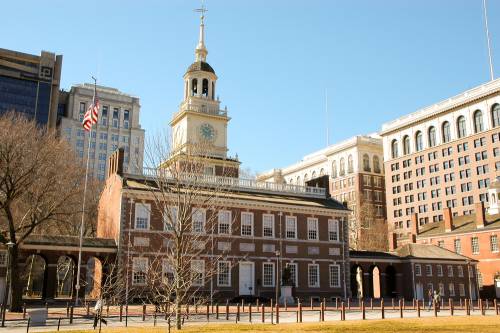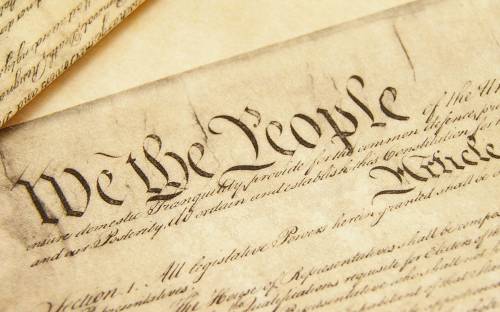Table of Contents

Madison's Final Resort
(source)
Posted by Robert Menges
on September 29, 2014
The Convention of States (COS) Project is a nationwide effort to bring about an amending convention under Article V of the United States Constitution. The historically accurate term for such a convention is a “Convention of States”. In late 2013, I took on the leadership role for the Convention of States Project in South Carolina. After over 15 years of teaching, speaking, and training people on the United States Constitution, the Rule of Law, and Original Intent, I came to the conclusion in early 2013 (as did many, many others around our nation) that our federal government is so systemically broken that those that hold federal office either cannot or simply will not take the steps necessary to return our government back inside the fence of limited government under the enumerated powers of the federal Constitution.
Because the framers of our great Constitution understood the nature of mankind, they knew there was a strong possibility that a day like this would come when the system that they entrusted to us would grow out of control. […] The framers also had a keen understanding that the system they designed was not perfect and therefore it would need a process to make necessary changes as they arose. To this end they inserted a rigorous change process that included two methods to amend the Constitution. It is abundantly clear from their own words that they foresaw the need for changes to the document in the future.
Many today tell us that we need to “defend the Constitution as it is” rather than amend it, altogether ignoring the fact that our Constitution has been changed by amendment 27 times. With the exception of two amendments (16 & 17 in my opinion), all of these amendments made necessary changes. The Bill of Rights codified specific individual rights, human slavery was eradicated, women were given the vote, Presidents were limited to two terms in office, etc… So this idea that we never amend the Constitution has no historical or logical basis. […]
Thomas Jefferson made this point very straightforward in his letter to Samuel Kercheval dated June 12, 1816:
Some men look at constitutions with sanctimonious reverence, and deem them like the arc of the covenant, too sacred to be touched. They ascribe to the men of the preceding age a wisdom more than human, and suppose what they did to be beyond amendment. I knew that age well; I belonged to it, and labored with it. It deserved well of its country. It was very like the present, but without the experience of the present; and forty years of experience in government is worth a century of book-reading; and this they would say themselves, were they to rise from the dead.
So in reality, the correct and Constitutional way to “defend” the Constitution when it is being abused is to amend it.
But let's dig deeper for a moment. A sober look back at recent history reveals that the twisting, pulling, and stretching of the text of the Constitution, away from its originally intended limited government, has been going on for well over a century. According to the founders/framers, what should have happened is that the very first time the Supreme Court twisted the original meaning of the Constitution in order to expand federal powers…the states should have responded with a call for an amending convention.
Click here to read the rest of Bob's article.

Can We Trust the Constitution? Answering the Runaway Convention Myth
Posted by Michele Musto on March 13, 2014 (source)
Some conservatives contend that our Constitution was illegally adopted as the result of a “runaway convention.” They make two claims.
1. The delegates were instructed to merely amend the Articles of Confederation, but they wrote a whole new document. 2. The ratification process was improperly changed from 13 state legislatures to 9 state ratification conventions.
The Delegates Obeyed Their Instructions from the States
The claim that the delegates disobeyed their instructions is premised on the idea that Congress called the Constitutional Convention. It is claimed that Congress instructed the delegates to solely amend the Articles of Confederation. A review of legislative history clearly reveals the error of this claim. The Annapolis Convention was the political impetus for calling the Constitutional Convention. The conclusion of the commissioners from the five participating states was that a broader convention should be called. They named the time and date (Philadelphia; second Monday in May). But who was to call the Convention?
They said they were going to work to “procure the concurrence of the other States in the appointment of Commissioners.” The goal of the upcoming convention was “to render the constitution of the Federal Government adequate for the exigencies of the Union.”
What role was Congress to play in calling the Convention? None. The Annapolis delegates merely sent a copy of their resolution to Congress and the executives of all states “from motives of respect.”
What authority did the Articles of Confederation give to Congress to call such a Convention? None. The power of Congress under the Articles was strictly limited, and there was no theory of implied powers. The States possessed residual sovereignty which included the power to call this convention.
Seven state legislatures agreed to send delegates to the Convention in Philadelphia prior to the time that Congress acted to endorse the Convention.
The States told their delegates that the purpose of the Convention was the one stated in the Annapolis Convention resolution: “to render the constitution of the Federal Government adequate for the exigencies of the Union.”
Congress voted to endorse this Convention on February 21, 1787. It did not purport to “call” the Convention or give instructions to the delegates. It merely proclaimed that “in the opinion of Congress, it is expedient” for the Convention to be held in Philadelphia on the date previously informally sanctioned by the Annapolis Convention and formally approved by seven state legislatures.
Ultimately, twelve states appointed delegates. Ten of these states followed the phrasing of the Annapolis Convention with only minor variations in wording (“render the Federal Constitution adequate”). Two states, New York and Massachusetts, followed the formula stated by Congress (“solely amend the Articles” as well as “render the Federal Constitution adequate”).
But every student of history should know that the instructions for delegates came from the states. You will recall that Delaware told its delegates never to agree to a plan that denied equal representation by states in Congress. That impasse had to be resolved.
In Federalist 40, James Madison answered the question of “who gave the binding instructions to the delegates.” He said: “The powers of the convention ought, in strictness, to be determined by an inspection of the commissions given to the members by their respective constituents.” He then spends the balance of Federalist 40 proving the delegates from all twelve states properly followed the directions they were given by each of their states. He specifically calls the February 21st resolution from Congress “a recommendatory act.”
The States, not Congress, called the Constitutional Convention. They told their delegates to render the Federal Constitution adequate for the exigencies of the Union. And that is exactly what they did.
The Ratification Process Was Properly Changed
The Articles of Confederation called for approval of any amendments by Congress and ratification by all thirteen states. Moreover, the Annapolis Convention document and a clear majority of States stated that any amendments coming from the Constitutional Convention would have to be approved in this same manner—by Congress and all 13 state legislatures.
The reason for this rule can be found in the principles of international law. The States were sovereigns. The Articles of Confederation were, in essence, a treaty between 13 sovereign states. Normally, the only way changes in a treaty can be ratified is by the approval of all parties to the treaty.
However, a treaty can provide for something less than unanimous approval if all the parties agree to a new ratification process before the change in process is effectual.
When the Convention sent its draft of the Constitution to Congress, it also sent a recommendation for a new ratification process. Congress approved both the Constitution itself and the new process.
Along with changing the number of required states from 13 to 9, the new ratification process stated that state conventions would ratify the Constitution rather than the legislatures. This was done in accord with the preamble of the Constitution—the Supreme Law of the Land would be ratified in the name of “We the People” rather than “We the States.”
But before this change in ratification could be valid, all 13 state legislatures would have to consent to the new method.
All 13 state legislatures consented to the new ratification process by calling conventions of the people to vote on the merits of the Constitution.
Twelve states held popular elections to vote for delegates. Rhode Island made every voter a delegate and held a series of town meetings to vote on the Constitution. Every state legislature consented to the new process that was aimed at obtaining the consent of the people themselves.
Those who claim to be constitutionalists while contending that the Constitution was illegally adopted are self-conflicted. It is like saying George Washington was a great American hero, but he was also a British Spy. I stand with the integrity of the Constitution.
Col. George Mason gives states a fighting chance
Posted by Jordan Sillars on November 25, 2013 (source)
Col. George Mason knew the federal government might one day become drunk with power. As Bob Menges (our SC State Director) explains, George Mason's wisdom and foresight during the 1787 Constitutional Convention gave the states the ultimate tool to halt federal abuses:
“On September 15, 1787, George Mason of Virginia (referred to in Madison's notes as Col Mason), was alarmed that in the text of Article V (the provision for making Amendments to the Constitution) Congress would have sole power to propose amendments; Mason insisted, as he did earlier in June, that the states have authority to call for conventions. Mason explained that an oppressive Congress would never agree to propose amendments necessary to restrain a rogue, tyrannical legislature.”
“By the time the convention reached its final days in mid-September, the Amendment provision had been added as Article V, and the provision had two methods; the national legislature (Congress) could propose Amendments and Congress could call for a Convention of States for the purpose of proposing amendments. However, both methods were left in the hands (power) of the national legislature. Mason had objected to this back in June and now as the convention drew to a close, he rose to his feet to forcefully object with his reasons stated above (“It would be improper to require the consent of the Natl. Legislature, because they may abuse their power, and refuse their consent on that very account”). Madison's notes of 15 Sept. tell us that Mason's motion was accepted and the language was changed in order to require [mandate] Congress to call a convention upon application of 2/3 of the states.”
“We owe George Mason and the other framers a huge debt for this. They had the foresight to understand first of all, that we needed an orderly process in which to amend our Constitution (“regular and Constitutional way than to trust to chance and violence” - Mason 11 June). Secondly, we owe them a huge debt for recognizing and understanding the depravity of man and the extremely intoxicating effects of years of power in the hands of the same people (hence a need for term limits), and that these power intoxicated occupants of the United States Congress would “abuse their power, and refuse their consent” (Mason 11 June) toany amendments that would “injure” themselves.”
Click here to read the full article.
The Founders laid the path—now it's our turn to follow it! If you want to reign in the abuses of Washington, if you want to ensure liberty for your children and grandchildren, now is the time to act. Sign up today!


